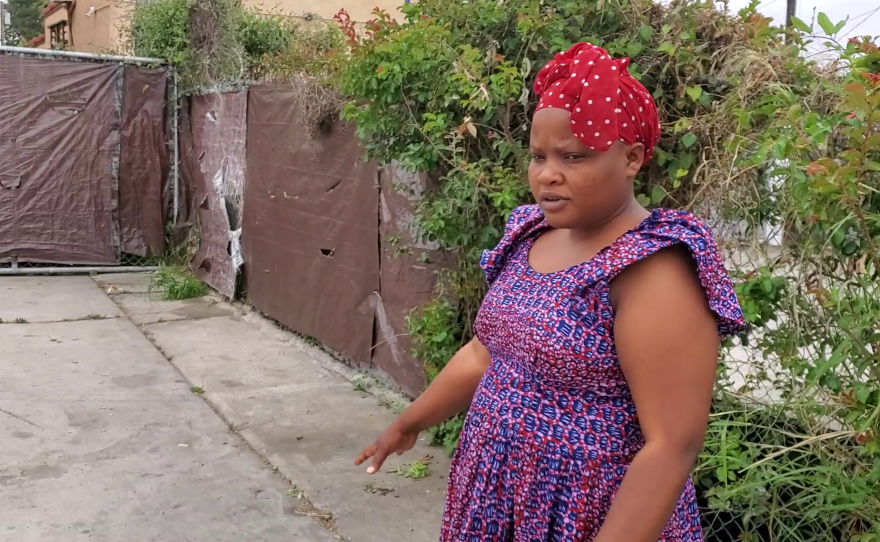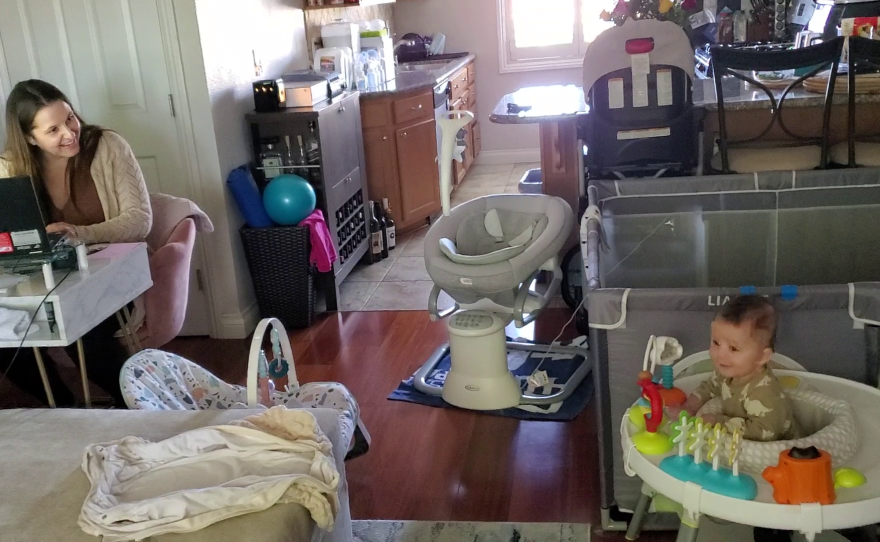On a Tuesday in May, Carolina Festo walked over the cracked concrete outside her home in City Heights and described her vision for something entirely different: a play space for kids.
“I want to fix the concrete and put in fake grass,” she said, pointing to a fenced-in lot in her backyard. “But it's a lot of money — I cannot afford to do that.”
A refugee from Burundi, Festo previously ran a home child care with 12 kids. When the coronavirus pandemic began in early 2020, she had to close, and not for health reasons. All of her clients were refugees who worked in hotel housekeeping who ended up being laid off, so they no longer could afford child care.
“I lost my clients because the parents didn't go to work, so they decided to stay with the kids,” Festo said.
Festo’s child care was one of almost 4,000 that closed in California after COVID-19 hit, according to data from the state licensing department. During the pandemic, many child care providers had to at least temporarily close their doors. But, two years later, the state data show that many have yet to open back up.
In San Diego County, 372, or about one in eight, child care centers closed after March 2020, with closures hitting the most vulnerable neighborhoods the hardest, the data show. Festo’s ZIP code in City Heights lost 10 home child care centers, among the largest drops in the state.
Now, like many child care providers that closed their doors, Festo is struggling to reopen. Her previous clients, and other refugees she would normally serve, are moving out of state — driven away by high housing costs.
“It was very tough and very difficult for me to come back in business because, as I was saying, a lot of clients moved out of San Diego because housing here is too expensive, and people can’t stay here,” she said.

Claire Trageser
Unequal impact
Even a small disruption is enough to put child care providers out of business — especially in lower-income areas, said Kim McDougal, the director of the Childcare Resource Service for the San Diego YMCA.
“A lot of them just couldn't make it. They didn't have a savings account they could rely on,” McDougal said. “Many of our higher-income communities were able to maintain their child care supply. And that's probably because they're able to charge a higher price for the care.”
And those businesses likely had a safety net, she said. Meanwhile, child care providers in lower-income areas lost clients when they were laid off, while higher-income families kept their jobs and their kids in care.
Beyond City Heights, ZIP codes in Escondido, Vista and Mira Mesa lost between 20% and 50% of their child care centers, according to the state data.
Government loans
Though there was some government funding and support for child care, it did not do enough to help. San Diego County gave grants to child care providers — from $2,750 for small home child cares to up to $50,000 for larger licensed child care centers. Festo said she applied for a grant, but didn’t receive any money. She did get a state grant for $5,000, which lasted a few months.
There were also loans, such as the federal paycheck protection loan program. While the PPP program funneled $235 million to more than 1,500 child care programs throughout the state, a 2021 analysis by KPBS and The California Newsroom found that it bypassed lower-income communities with higher concentrations of minority groups. Just 4% of the child care businesses that closed statewide received PPP loans.
In San Diego County, most of the PPP loans went to higher-income areas such as Poway and La Jolla. Not one child care business in City Heights received a loan.
Festo didn’t apply for a loan — she was scared of going into debt, and didn’t know that PPP loans would be forgiven. Had she known that, she might have had the money today to build an extra room in her home and care for kids whose parents work night shifts.
In a KPBS survey of child care businesses, two-thirds of the 90 respondents said they did get subsidies — on average $46,000, which covered about 11% of their budget. Less than a quarter of respondents said the money was enough, and almost half said they’re still worried about having to close.
One issue was that the government grants didn’t come quickly enough, said Donna Sneeringer, the chief strategy officer for the Child Care Resource Center.
“The first round of stipends came in the summer of 2020 out of initial federal CARES Act funding, but, by the time the dollars went out, those that were on the edge were already gone,” she said.
Other government assistance
The government did make other changes to help the child care industry, but not quickly enough, said Nina Buthee, the executive director of EveryChild California.
“They gave out a lot of PPE, like masks, gloves and cleaning supplies, but the rollout was strange,” she said. “There were truck pallets being delivered to child care centers that don’t have a loading dock.”
McDougal, of the YMCA, said there were several other things that the state could have done. They include: providing health insurance to child care providers, increasing the rate the state pays providers for children on subsidies and increasing the number of days providers can be paid despite being closed.
“If a center has kids on subsidies, they can have 10 nonoperation days a year and still charge the state for those,” she said. “During COVID, they increased the number to 16, but that’s still not nearly enough. If you had multiple COVID outbreaks, that would be nothing for you.”

Claire Trageser
Infant care crisis
The declining number of child care spots is something Ariana Steck feels pretty much every minute of the day. Steck is a mother of a 6-month-old who works from home for the YMCA.
On a recent afternoon, she sat at a desk in her small North Park apartment with four different baby contraptions all within arm’s reach. Her son, Griffin, stood in a jumper surrounded by colorful buttons that played music.
“I started using a licensed family child care home for one day a week,” she said. “And the rest of the days I am child care and employee.”
Steck has been back at work for a month. While she put Griffin on child care waitlists long before he was actually born, she hasn’t been able to find full time care.
“Many centers didn't have vacancies until the winter of 2022,” she said. “One center told me they had over a hundred infants on their wait list. He's going to be in preschool by the time they call us.”
Steck can’t wait that long, so she’s left with a brutal balancing act.
“My very first week back, I started my days at about 4 in the morning, and he slept until 7,” she said. “So I got 3 hours to work then, and then I’d work during his naps and again after his Dad got home.”
That wasn’t sustainable. Now Steck gets a little more sleep and tries to work while Griffin plays.
“Like, when he’s doing tummy time in his bedroom, we have a little footstool in there, and I park my laptop on that, and he's sitting right next to me,” she said.
Steck actually works in part with child care referrals for the YMCA, so she has better knowledge of child care than almost anyone. And, when she was pregnant, she knew there was a child care crisis.
“But, once you're sitting in it, you're like: ‘Oh, this is a crisis,’” she said. “There is a legitimate thing happening here where there is a huge demand for infant care, and the supply is just not there.”
In part two of this series, on Thursday, we’ll look at a new problem for providers: rising rental and housing costs.
"care" - Google News
June 01, 2022 at 08:01PM
https://ift.tt/fIOFu9t
The pandemic's toll on San Diego County child care businesses is still being felt - KPBS
"care" - Google News
https://ift.tt/74sgIkY
Shoes Man Tutorial
Pos News Update
Meme Update
Korean Entertainment News
Japan News Update
Bagikan Berita Ini














0 Response to "The pandemic's toll on San Diego County child care businesses is still being felt - KPBS"
Post a Comment